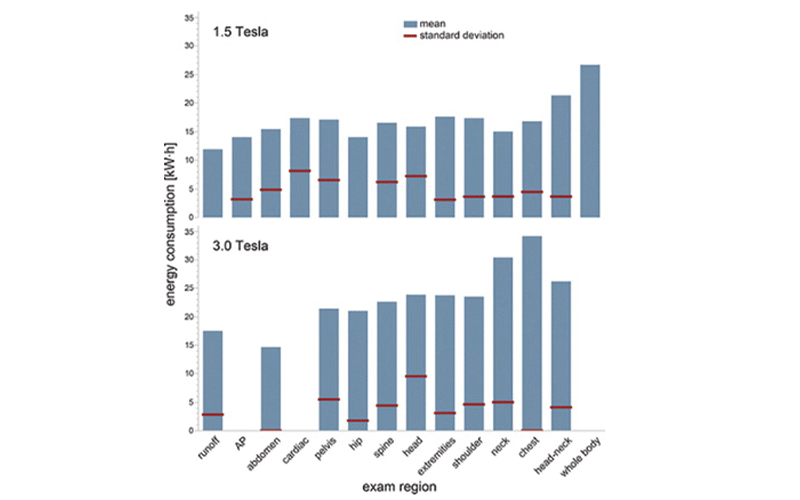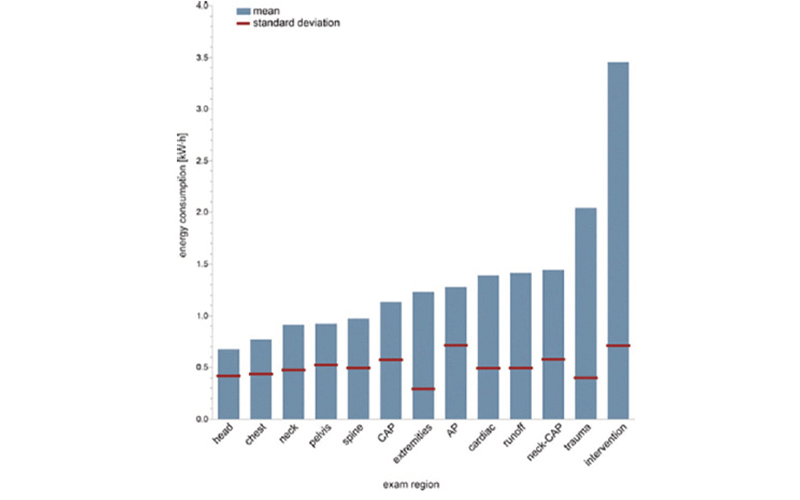Assessing Radiology’s Impact on the Environment
Research shows radiology is a significant contributor of greenhouse gases


Radiology’s impact on the environment is a good news, bad news proposition.
First, the bad news. Radiology departments consume a considerable amount of energy and generate a substantial volume of greenhouse gases, according to recent studies.
The good news? The research reveals promising opportunities to reduce a department’s carbon footprint without sacrificing patient care and safety.
Greenhouse gases are byproducts of burning fossil fuels that trap heat in the atmosphere and have been implicated in global warming. One of the most cost-effective ways to reduce greenhouse gases is through increased energy efficiency; in other words, using less energy to get the same job done. As an industry that generates about 10% of U.S. greenhouse gases, the health care sector is ripe for energy savings.
“Our practices in medicine have evolved to prioritize patient safety, cost savings and convenience, which makes sense, but historically we haven’t prioritized environmental sustainability,” said Jonathan Gross, MD, an interventional radiologist at NYU Langone Health in New York City.
Dr. Gross and colleagues published a 2021 study in the Journal of Vascular and Interventional Radiology that analyzed greenhouse gases generated by a hospital-based interventional radiology (IR) department in a typical five-day workweek.
The researchers concluded that the practice of IR generates substantial greenhouse gas volumes, a majority of which come from energy used to maintain climate control in the IR suite.
“We found that more than half of the emissions that were generated by our climate control system, and ultimately about a quarter of the emissions produced during the entire study, were generated at night and on weekend hours when the IR suite is rarely in use,” Dr. Gross said. “There’s definitely room for improvement there.”
Watch Dr. Gross discuss his study and ways radiology department's can lessen their environmental impact:
Simple interventions like installing occupancy sensors in rooms can boost the efficiency of climate control systems and save money as well, Dr. Gross said.
Emissions related to single-use surgical supplies were the second largest source of emissions in the study. Dr. Gross said that a mindful approach to the use of surgical supplies, such as opening only the equipment needed for a particular procedure and choosing reusable rather than single-use supplies whenever possible, can significantly reduce emissions.
To reduce its environmental footprint, Dr. Gross’s department has shifted away from using single equipment packs for every type of IR procedure in favor of kits that include different types and amounts of supplies. Interventional radiologists are able to choose the appropriate kit based on what they anticipate they’ll need for each procedure.
“A more mindful approach shouldn’t impact the quality of care we provide the patient, but it should substantially decrease the impact that we have on the environment,” Dr. Gross said.
"Addressing the idle time energy consumption has by far the greatest energy saving potential since it reflects such a large amount of operation time on MRI and CT."
Tobias Heye, MD
Watch Dr. Heye discuss his research on imaging equipment's energy use:
Imaging Technology is “Energy Hungry”
The findings come a year after a study published in Radiology determined that, over the course of a year, CT, MRI and related cooling systems in a university hospital’s radiology department use as much energy as a small town.
In the study, Swiss researchers discovered that the overall energy consumption in the department was equivalent to the usage in a town of 852 people and constituted 4% of the total yearly energy consumption at the hospital.
“First and foremost, our results show that our cross-sectional modalities are quite energy-hungry, especially MRI with its overall high energy need,” said study lead author Tobias Heye, MD, from the Department of Radiology at University Hospital Basel in Basel, Switzerland. “We also learned that a lot of energy goes into counteracting heat, which arises as a side product from operating modalities. The cooling process requires even more energy.”

Bar graphs show mean energy consumption of MRI examinations and standard deviations in kilowatt-hours per body region stratified according to field strength and averaged from 1 year of data. AP = abdomen and pelvis.
Heye et al, Radiology 2020: 295;3 ©RSNA 2020
Idle state consumption was four-fold that of net consumption, suggesting considerable energy saving potential in minimizing consumption during these hours. CT scanners, for instance, could be shut off during off hours, something not done at many institutions for reasons of convenience. This would reduce consumption by 50% in a practice with 12 off hours in a day, according to Dr. Heye.
“I would say that addressing the idle time energy consumption has by far the greatest energy saving potential since it reflects such a large amount of operation time on MRI and CT,” he said. “Hopefully, vendors recognize that the energy savings is urgent, and in the end can also save a considerable amount of money.”
To reduce energy consumption associated with cooling, Dr. Heye’s institution implemented a centralized system that offers temperature-variable cooling on demand for more efficient operation. Leaders at the institution are also investigating ways to use excess heat from the modalities for other applications in the hospital like the warm water supply.
Even with the adaptations, Dr. Heye warned that significant improvements in energy efficiency are not possible without vendor support.
“I hope vendors get the message, but I fear conflicting interests such as profitability may compete with the task of implementing energy saving technology,” he said.

Bar graph shows mean energy consumption of CT examination and standard deviation in kilowatt-hours per body region averaged from 1 year of data. AP = abdomen and pelvis, CAP = chest, abdomen, and pelvis.
Heye et al, Radiology 2020: 295;3 ©RSNA 2020
Advocating for a Sustainable Future
In the meantime, new initiatives are helping to raise awareness of radiology’s environmental impact. A group called Radiologists for a Sustainable Future (R4SF) recently organized with the goal of promoting sustainability in the practice.
At NYU Langone, a sustainability advisory group composed of both clinicians and sustainability experts is spearheading multiple initiatives to recycle plastic, reduce waste from operating rooms and the IR suite, and donate equipment that has expired but is still safe to use.
Efforts like these are likely to accelerate as more research becomes available on radiology’s energy consumption and greenhouse gas emissions.
“Radiology needs to advocate for research and for policies that will help us reduce the harm that we’re doing to our environment while we continue to try to do good for our patients,” Dr. Gross said. “This is an area that’s wide open for research — one in which we can have an outsized impact on public health and help make the world a better place for our ourselves, our patients and our children.”
For More Information
Access the Radiology study, “The Energy Consumption of Radiology: Energy- and Cost-saving Opportunities for CT and MRI Operation.”
Access the Journal of Vascular and Interventional Radiology study, “The Environmental Impact of Interventional Radiology: An Evaluation of Greenhouse Gas Emissions from an Academic Interventional Radiology Practice,” at pubmed.ncbi.nlm.nih.gov.
Read the Radiology commentary, “Radiology and the Climate crises: Opportunities and Challenges, – Radiology in Training.”